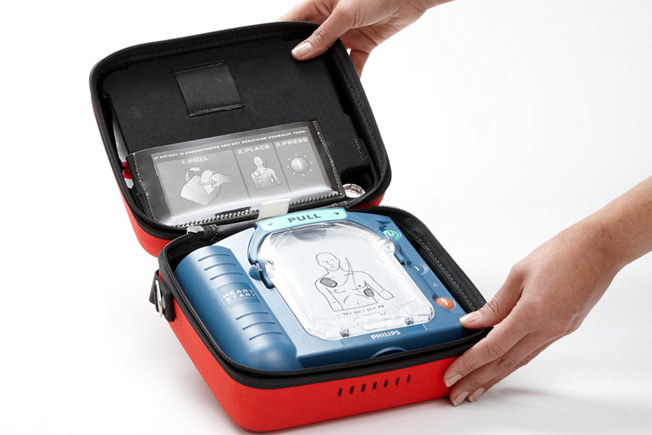
You’ve seen them around. In the metal wall containers in subway stations, in malls and community centres…AEDs are everywhere. Why? Because they work. When your heart needs it, along with effective CPR, an AED can save your life by kickstarting your heart back to normal. To understand how, you have to know a bit about how your heart works.
Your Heart is a Muscle
It’s about the size of your fist and is in the upper left side of your chest (just off the centre). And your heart has an incredibly important function. It pumps blood to all areas of your body. But not just blood. In that reddish liquid is oxygen that each one of your cells need. As well as all the nutrients, energy, antibodies, pretty much everything necessary for your body to survive. Without your heart pumping these things throughout our body (and our brain), our body would just stop working…and quite frankly, we would die.popping up everywhere. Soon in restaurants too. And there is good reason. AEDs save lives.
But the heart keeps pumping. All day, all night. Sometimes it speeds up, sometimes it slows down, but as long as it keeps pumping, we are in pretty good shape.
Your Heart is Electrical
Like all of your muscles, the signal that contracts the muscle fibres of the heart is, in a way, self-electrocuting at a specific rhythm, so that the parts of the heart contract in just the right way. The contraction starts at the top of the heart…and the left and right atria contract. This sends blood rushing down into the ventricles, the larger chambers of the heart. Then the ventricles the contract and send the blood rushing out of the heart…some of the blood goes to the lungs to get some more oxygen (and release CO2), and the rest gets pumped to the rest of the body.
But what is very important is this rhythm. The atria, then the ventricles, the atria, then the ventricles, and so on. And at the right pace so that the atria and ventricles have a chance to fill back up between contractions. When the electrical pattern gets messy and disorganized, we get into trouble because the heart does not effectively pump the blood around the body. Another word for this ‘messy’ electrical activity is called: FIBRILLATION.
And this is where AED comes in:
AED = Automatic External Defibrillator
AED’s specific purpose is to DEfibrillate the heart. It does this by giving the heart a jolt of electricity that resets the ‘internal pacemaker’ of the heart back into a normal sinus rhythm. AEDs are incredibly easy to use. You just apply the sticky pads to the person’s body as it’s shown on the machine, turn it on and step back. The AED automatically analyzes the person’s heart electrical activity and will either recommend, or not recommend a shock. If a shock is recommended, the AED will charge and tell you when it’s ready to shock, which you, as the rescuer do by pushing the red, flashing button.
AEDs are now more affordable than ever. If either you, or someone you love have a heart condition or is at elevated risk for arrhythmia (irregular heart rhythm) or cardiac arrest, you may want to consider having a home AED machine just in case. If it was needed, the quicker it is applied, the higher the chances it will save your life. Having an AED on site decreases the delay that could be fatal for someone in need.
Check out First Aid Canada’s line of Philips HeartStart AEDs for the best AEDs on the market: www.firstaidcanada.com/aed.
And nothing goes better with AED than CPR…all First Aid Canada’s CPR and First Aid courses incorporate AED training into the curriculum. Customers who purchase a Philips HeartStart AED from First Aid Canada are eligible for a 10% on all CPR/First Aid Courses (6-10 participants).
Life is Precious. Be Prepared.
